
Best Small Space Entryway Solutions That Work for Every Home
Small Space Entryway Solutions That Work
Let’s be honest — small entryways can be a nightmare. Shoes everywhere, keys lost, and clutter that makes coming home stressful. But a few smart storage ideas can turn even the tiniest hallway into a stylish, functional space that actually works.
Key Takeaways
-
Maximizing vertical space with wall hooks, floating shelves, and tall storage solutions helps keep your small entryway organized without sacrificing precious floor space.
-
Choosing slim, multifunctional furniture like storage benches and floating consoles creates a stylish entryway that works hard without feeling bulky.
-
Thoughtful lighting, mirrors, and minimal clutter can visually expand your entryway, making even the smallest space feel welcoming and open.
Why Bother Fixing Up a Tiny Entryway Anyway?
Because that’s where the first impression is made! It’s the first thing you see when you walk in — and the last thing when you leave. If it’s cluttered, messy, or dark, it affects how you feel about your whole home.
I used to live in a flat where the “entryway” was basically a glorified doormat. I hated it. But once I added just a few small changes — some hooks, a narrow bench, a mirror — suddenly it felt intentional, not accidental.
So yeah, even the smallest spaces can be beautiful. With a little strategy (and maybe a bit of stubbornness), you can create a stylish entryway that makes a big impact, no matter the size.
1. Use Your Vertical Space Like a Pro
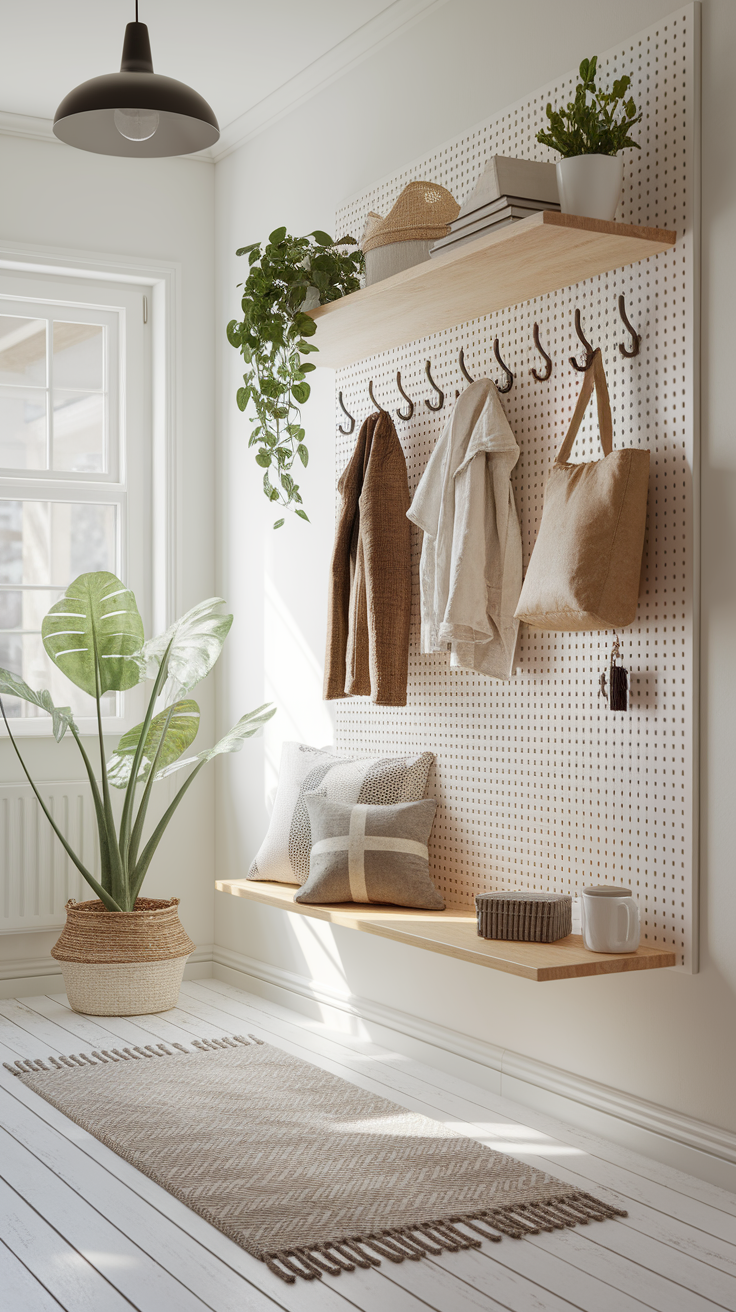
When floor space is precious, the walls become your best friends. Seriously — start thinking up, not out. Vertical storage solutions help maximize available space in a small entryway by utilizing wall height for shelves, hooks, or cabinets.
Hooks and Rails Are Game Changers
Forget big coat racks. Mount a few sturdy hooks or a slim wall rail at different heights. Hang coats, scarves, bags, umbrellas — basically everything that tends to pile up. You can hang things like hats, bags, and even bulky coats to keep your entryway organized.
Pegboards are another lifesaver. You can rearrange the pegs whenever your needs change. (I swear by mine — it holds everything from dog leads to reusable shopping bags.)
Choose sturdy hooks that are strong enough to hold bulky coats, so you don't have to worry about them bending or breaking.
Floating Shelves for the Win
A small floating shelf right by the door gives you somewhere to drop keys, mail, or sunglasses. Open shelving can also be used in small entryways to maximize space, provide functional storage, and add character by displaying decorative items. It doesn’t block the walkway, and you can style it with a plant or candle if you’re feeling fancy—these touches add character to the entryway.
Bonus tip: A mirror with built-in hooks or shelving kills two birds with one stone — storage and light reflection.
Loft-Style Storage for Overflow
If you have tall ceilings, use that extra space! Adding a shelf above the door or near the ceiling is a great way to create extra storage space in a small entryway. It's perfect for items you don’t use daily — think hats, seasonal gear, or spare bags. Just keep a small step stool handy (and maybe label the bins so you’re not guessing what’s up there).
2. Choose Slim, Multifunctional Furniture
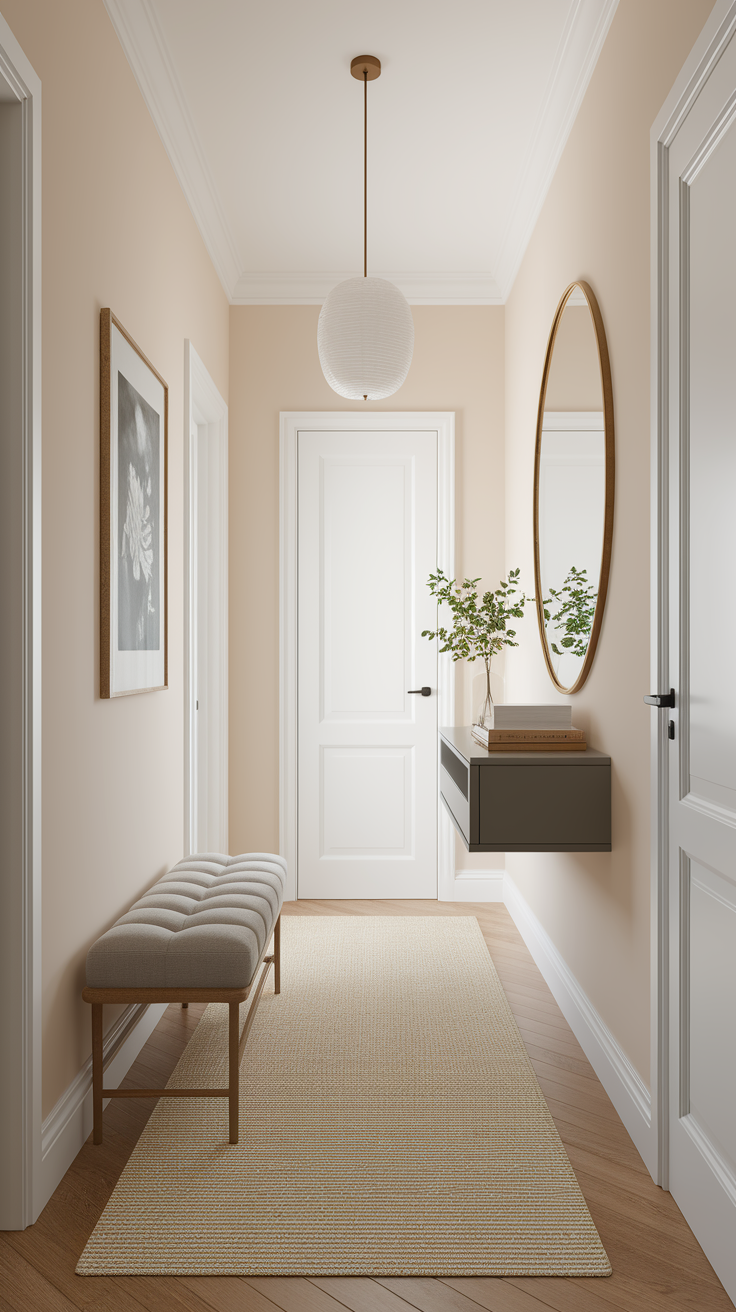
Small space? That doesn’t mean no furniture — it means smart furniture. In a narrow entryway, avoid bulky furniture and instead choose slim, space-saving pieces that maximize functionality without overwhelming the area.
Benches With Storage
A narrow bench with hidden storage is a total win. You get a seat for putting on shoes and a place for storing shoes and personal items inside the bench when you’re done.
I once found a second-hand storage bench that looked way too small to matter — but wow, it swallowed a ton of clutter. Instant calm.
Shoe Cabinets That Don’t Hog Space
Look for shallow shoe cabinets — some are only 20–25 cm deep but hold several pairs. These shoe storage solutions keep shoes out of sight with closed storage, and the top doubles as a little display surface.
Floating Consoles
A wall-mounted console or mini drawer unit, similar to a slim console table, gives you that “entryway table” vibe without hogging the floor. A floating console can be installed on the entryway wall and also looks sleek and modern — like it’s just floating there, making your space feel bigger than it is.
Under-Stair or Built-In Magic
If you’re lucky enough to have stairs nearby, use that under-stair zone! Built-in storage in this area can serve as a smart alternative to an entry closet, especially in homes where a traditional closet is missing or inconveniently located. Shallow cupboards, cubbies, or pull-out drawers make fantastic entryway storage, providing valuable space for shoes, bags, and jackets while keeping the area organized and clutter-free. One of my friends even managed to hide a fold-up stroller there. Genius, right?
3. Trick the Eye With Light and Mirrors
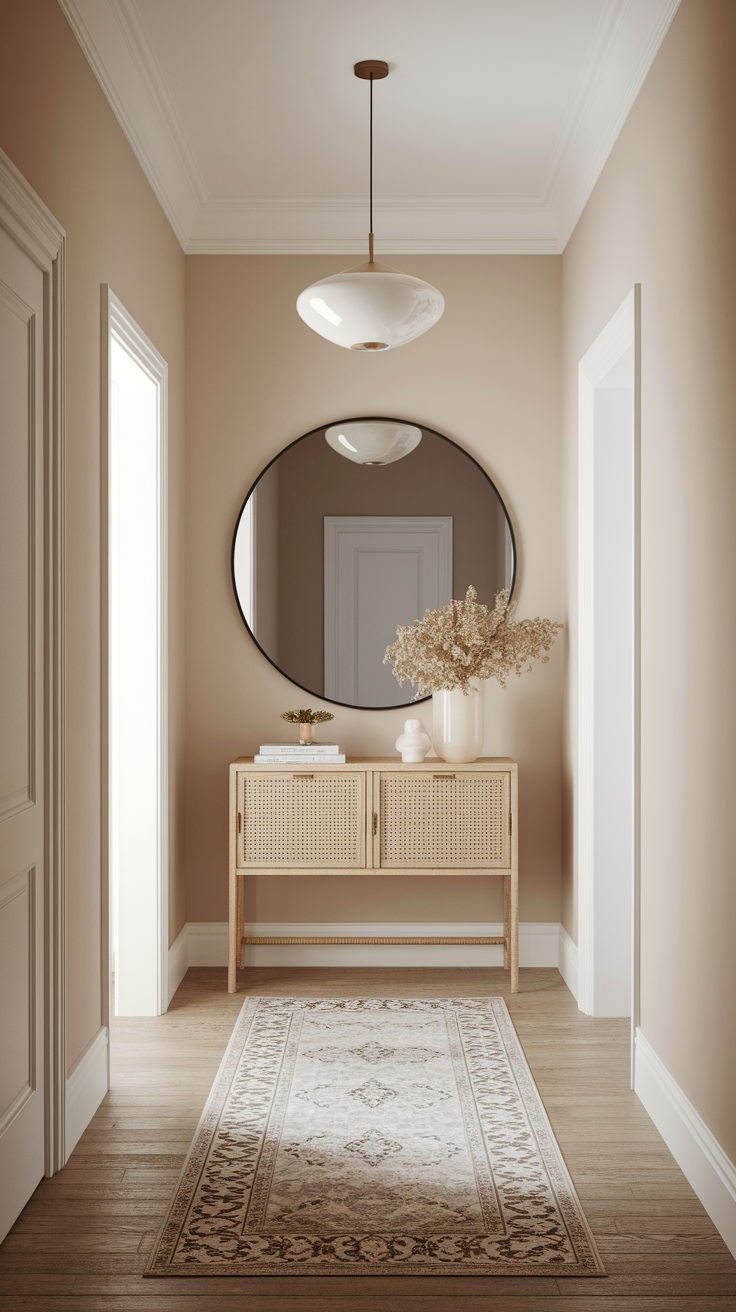
You can’t magically expand your walls, but you can make them feel wider. Mirrors are a classic trick for visually doubling the space. A well-placed wall mirror can help reflect natural light, making the entryway feel brighter and more open.
Mirrors Are Your Secret Weapon
Hang a large mirror or even a full-length one opposite the door to bounce light around, which works especially well in small entries by making them feel larger and more open. It instantly opens the space and adds a touch of sophistication.
If you can, angle it so it reflects a window or brighter part of the room — that doubles the illusion of space.
Lighting Matters — A Lot
Dim, yellow light makes a small entryway feel even smaller. Go for bright, warm lighting instead. Try:
-
Wall sconces (they don’t take floor space)
-
LED strips under shelves or benches
-
A compact ceiling pendant if you have height
Lighting transforms mood — so even if you do nothing else, fix that first.
Paint and Visual Tricks
Color plays a huge role. Use light, neutral colors to open things up. Or, if you’re feeling bold, try a two-tone wall — darker on the bottom, lighter on top. It draws the eye upward. Consider using textured finishes or adding elements like board and batten to add texture to the entryway and create visual interest.
And don’t underestimate rugs! A long runner rug with a linear pattern can make the hallway feel longer (and way cozier), and also add warmth to the space.
4. Build a “Drop Zone” for Everyday Chaos
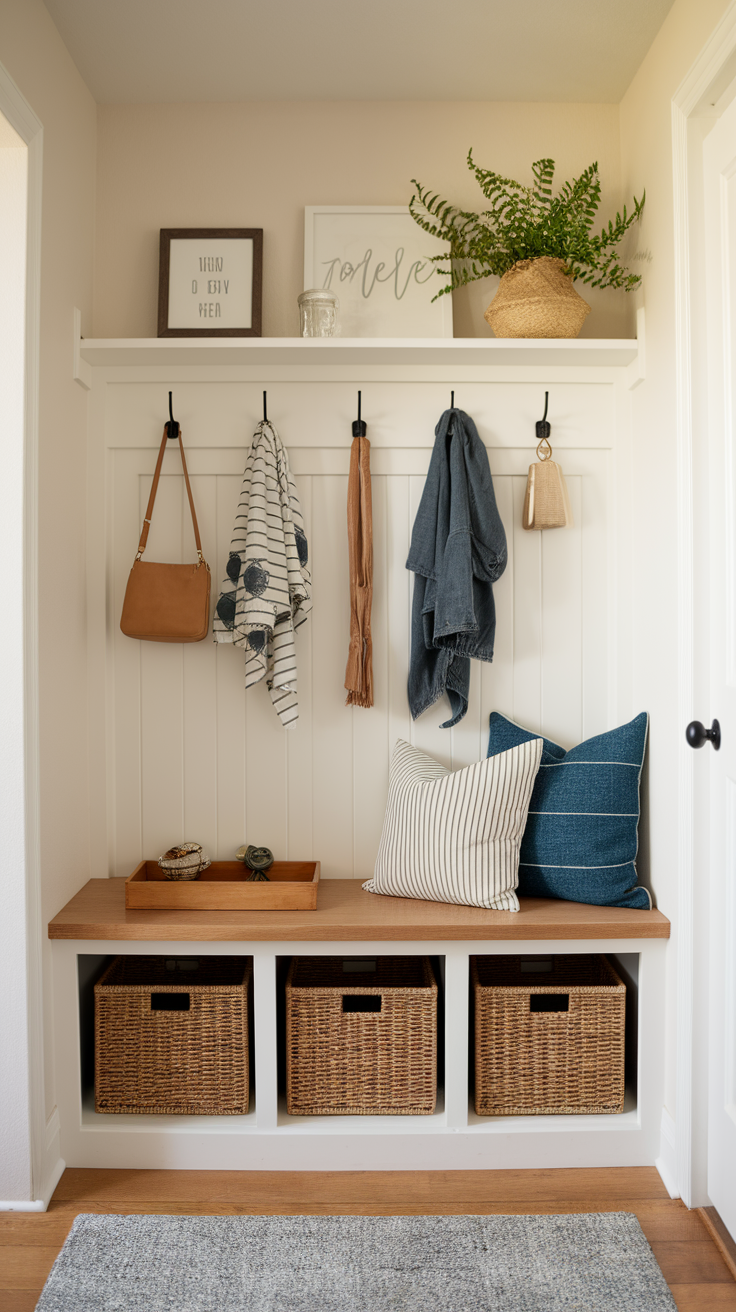
Let’s be real — clutter is the enemy. Especially in small spaces.
Creating a dedicated drop zone is life-changing. No more keys lost in coat pockets or sunglasses sitting on the microwave (yes, I’ve done that).
Here’s what to include:
-
A tray or small dish for keys, change, or lip balm
-
A key hook or dedicated key storage to keep your keys in one place
-
A wall-mounted mail sorter for post and papers
-
Baskets under a bench for shoes, scarves, or pet gear
-
Hooks for bags and jackets (bonus points for different heights)
-
Labels or zones if you share the space with family — less fighting over “who dumped this here!”
Remember, not everything needs to be kept in the entryway—just the essentials.
When I set mine up, I made one rule: only two pairs of shoes per person allowed in the entryway. It sounds ridiculous, but it works. The rest stay in a closet. No exceptions.
5. Be Ruthless About What Doesn’t Belong
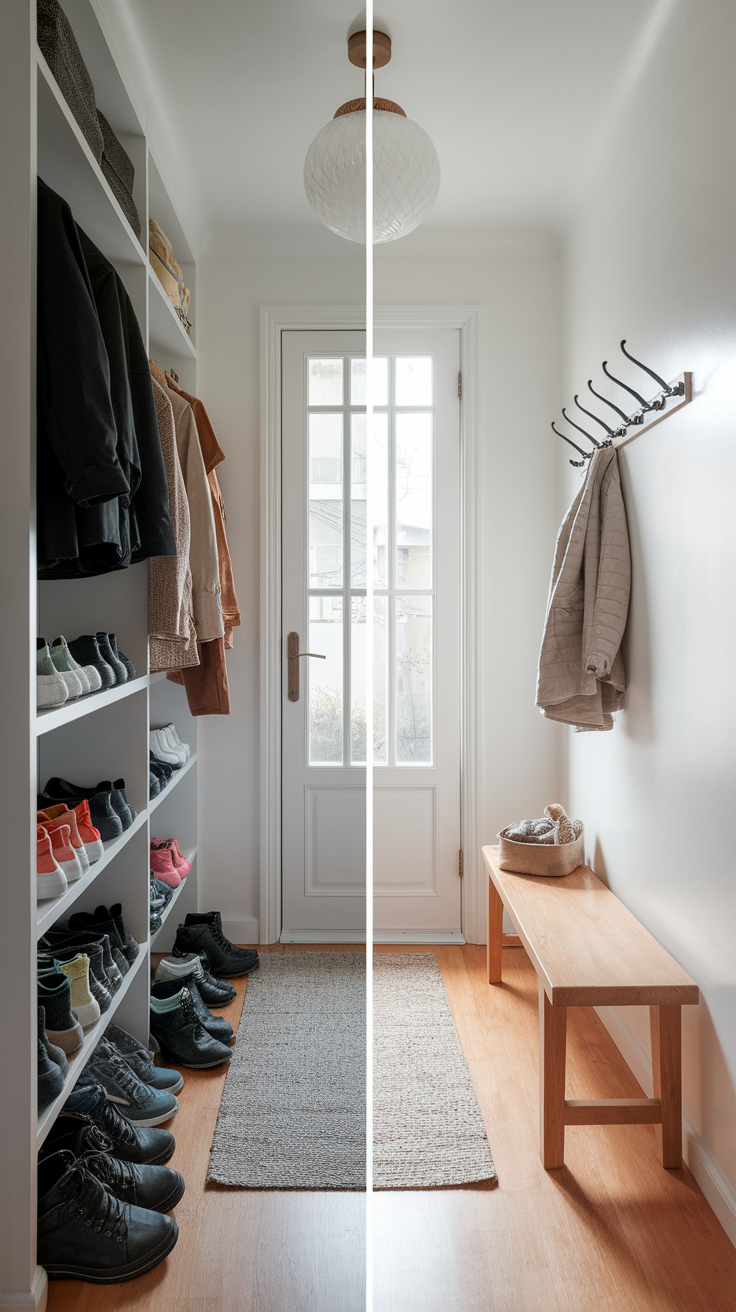
If your entryway feels cramped, it probably has too much stuff. Sorry, but the truth hurts.
Things to avoid like the plague:
-
Oversized furniture that blocks your walking path
-
Big floor lamps or standing coat racks
-
Too many decorative pieces (pick one or two max)
-
Thick rugs that trip you up
-
Giant artwork that overwhelms the wall
The goal is flow. You want to glide through your entryway, not sidestep around a chair or vase.
I once swapped out a cute umbrella stand for wall hooks — boom, two square feet reclaimed instantly. Sometimes “minimal” just means “more room to breathe.” You can keep things minimal without sacrificing style, choosing storage solutions that look great and keep your space functional.
6. Add Personality Without the Clutter
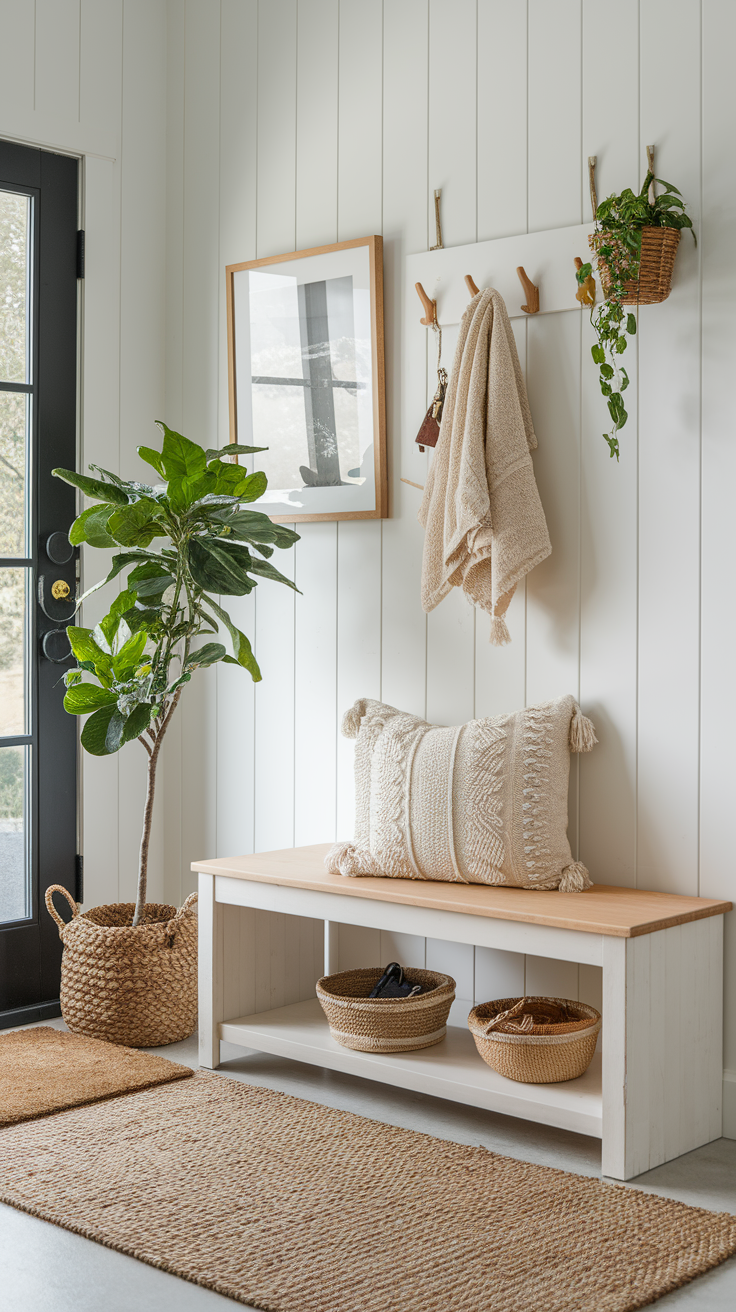
Even small spaces deserve a little flair. Thoughtful styling and home decor choices can add charm to a small entryway, making it both functional and inviting. Don’t let function completely smother your style.
Here’s how to make it personal without turning it into a junk zone:
-
Add a small plant (bonus: it purifies air and softens the look)
-
Hang one framed photo or print that makes you smile
-
Use decorative trays or bowls for keys instead of plain ones
-
Swap out cushions or doormats seasonally for easy refreshes
-
Try color blocking or painted accents on one wall
One of my favorite hacks: I found a piece of driftwood on holiday, attached hooks to it, and mounted it by the door. It’s functional, rustic, and reminds me of that trip every time I come home. Win-win.
7. Real-Life Example: Tiny Entryway, Big Transformation
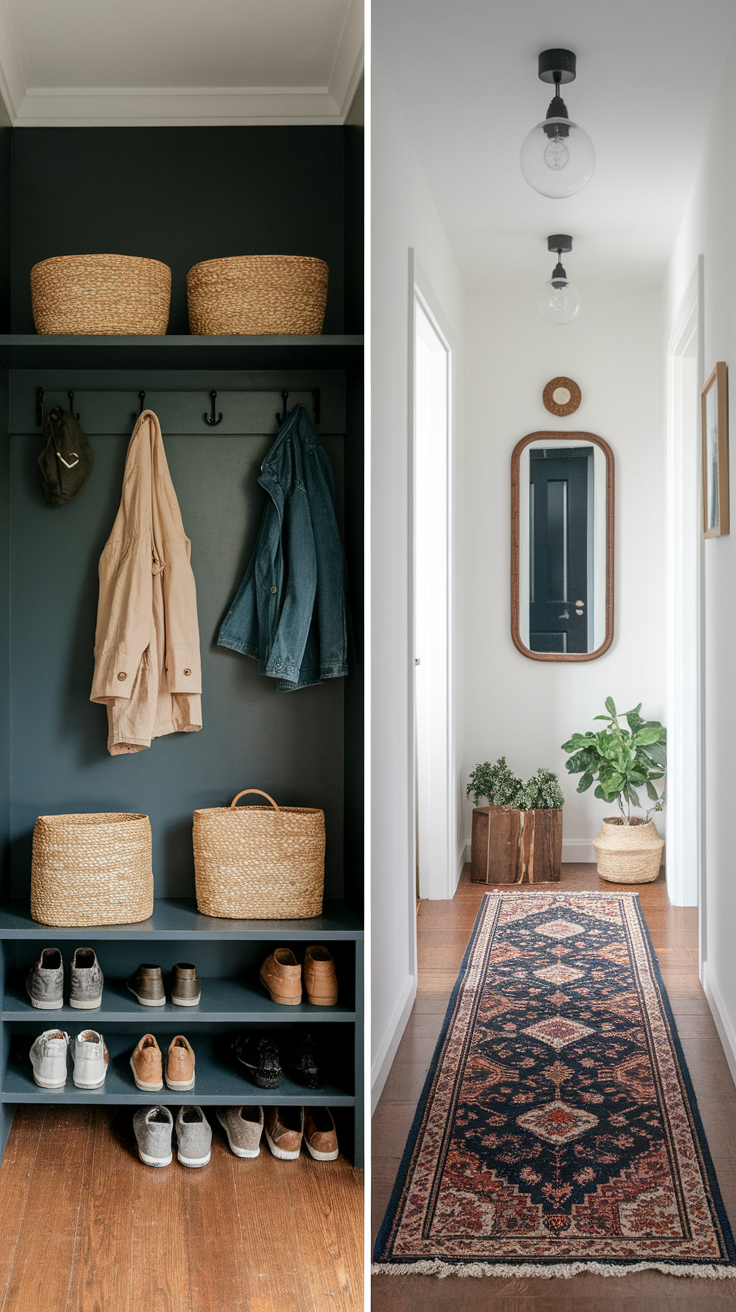
Let’s imagine you have an entryway about 1.2m wide and 1.8m long — not exactly generous.
Before, shoes piled up by the door, coats draped over a single hook, and bags cluttered the floor. After implementing a few simple changes—like adding a slim bench with storage underneath, wall-mounted hooks, and a narrow shelf—the space is now tidy and welcoming. By using the best ideas for small entryways, you can maximize storage and organization, making even a tiny area feel functional. These strategies also help create a sense of open space, so your entryway feels less cramped and more inviting.
Before
-
Pile of shoes at the door
-
Bulky table that sticks out too far
-
Coats draped over chairs
-
Dim light, no mirror, no order
After
-
Replace table with a floating shelf (make sure it is securely hung to support any items placed on it)
-
Add hooks above it (ensure the hooks are properly hung for safety and stability) and a small mirror above those
-
Slide in a narrow bench with baskets underneath
-
Mount a wall sconce or LED strip for soft lighting
-
Add a runner rug to define the space
-
Paint the walls a soft neutral color and add a small plant
For extra personality and visual interest, consider creating a gallery wall above the shelf or along the entryway to make the space feel larger and more inviting.
Suddenly, it feels like a real room. Clean, functional, and welcoming — without any extra square footage.
8. Quick Fixes and Pro Tips
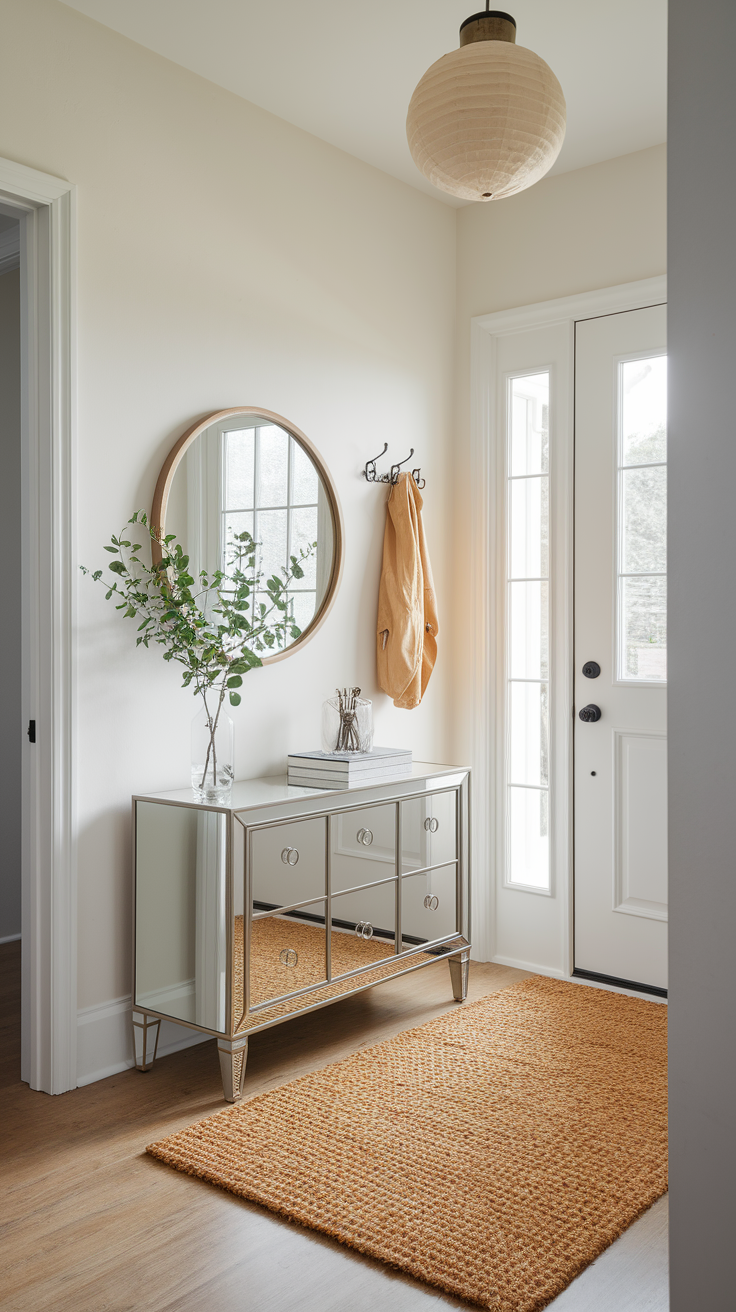
Here are a few bite-sized ideas if you’re short on time or energy—especially helpful for small apartments:
-
Use over-the-door hooks for temporary hanging
-
Hide cables and random clutter with adhesive clips
-
Install magnetic strips for keys or metal items
-
Use mirrored furniture for light reflection
-
Keep only daily-use items at the door — rotate seasonally
Clutter often piles up on the kitchen table, which tends to become a catch-all drop zone in many homes, especially in open-plan or compact spaces.
And please, don’t underestimate the power of a good doormat. A stylish one not only traps dirt but adds instant personality right at the threshold.
9. Common Entryway Questions (Because Everyone Asks)
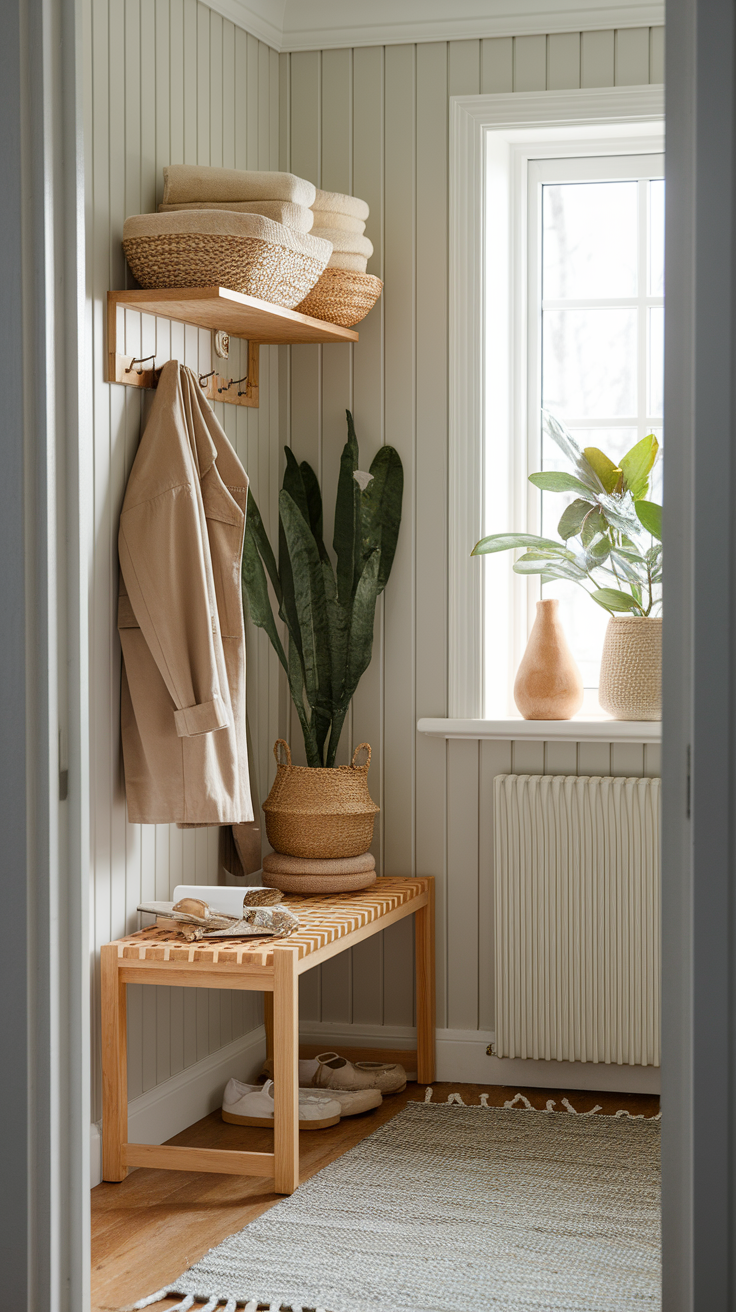
Q: My entryway opens straight into the living room — what can I do?
Create a visual boundary. Use a rug, lighting, or small console to mark where the entry “zone” begins. Even a change in wall color or flooring can help.
Q: I hate clutter but also love decor. How do I balance both?
Stick to the “rule of three”: three decorative elements max (like a mirror, small plant, and tray). It keeps the look curated, not crowded. Advice from an interior designer or creative director can also help you balance function and style, ensuring your entryway remains both practical and visually appealing.
Q: What if I rent and can’t drill into walls?
Use adhesive hooks, free-standing slim furniture, and removable wall shelves. Command hooks and tension rods are your new best friends.
Q: How can I make it cozy without adding stuff?
Lighting, rugs, and color — that’s your holy trinity. Warm light, soft textures, and cohesive tones do wonders. Incorporate natural materials like wood or wicker to add warmth and texture to your entryway.
Final Thoughts: Make It Work for You
At the end of the day, small space entryway solutions that work aren’t about copying Pinterest-perfect photos — they’re about finding what actually fits your life.
The best designs balance function, style, and flow. If it makes your mornings smoother and your evenings calmer, you’ve nailed it.
My own entryway? Hooks for days, a mirror that fakes square footage, and a bench that hides my embarrassing shoe collection. It’s not massive — but it works, and it makes me smile every time I come home.
So go take a look at your own entryway right now. What’s the one thing you could tweak today? Maybe it’s adding hooks, swapping furniture, or just decluttering. Start there. Small steps, big difference. :)





